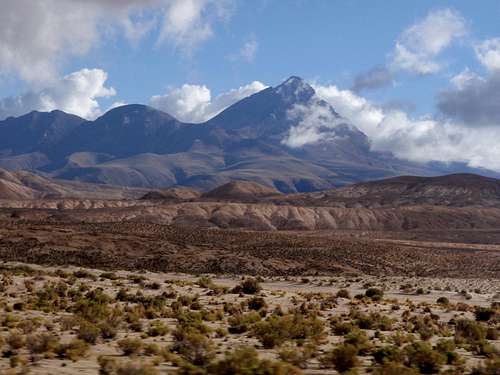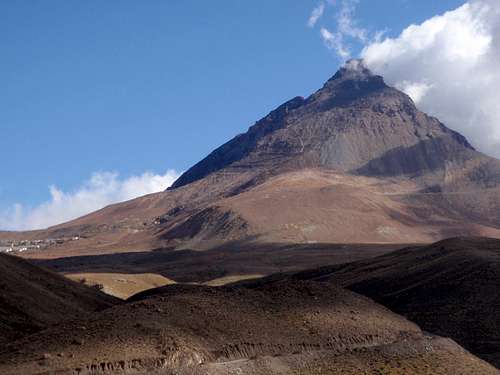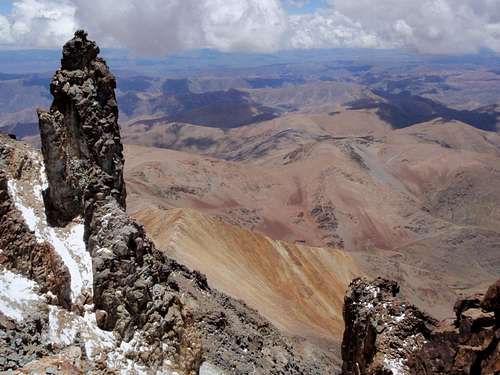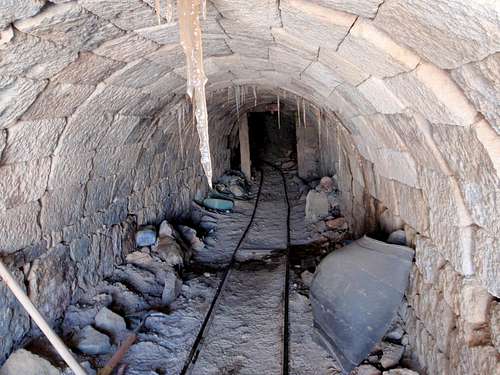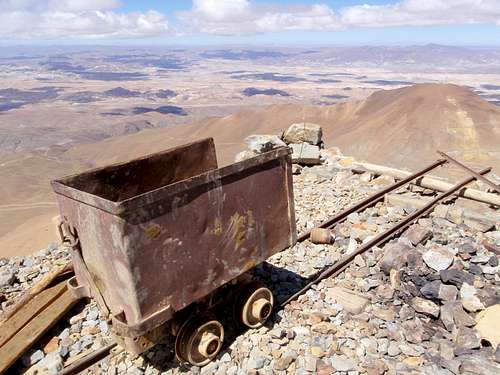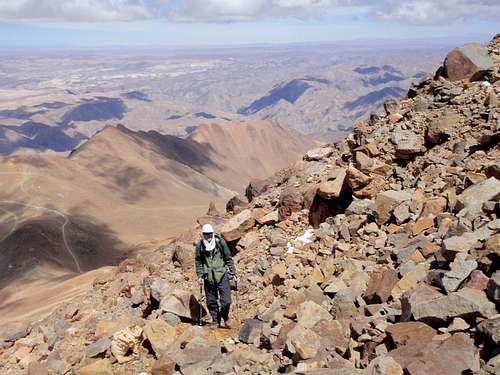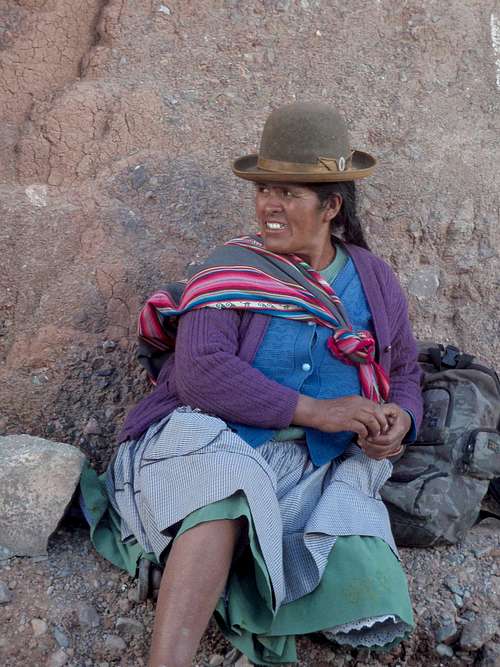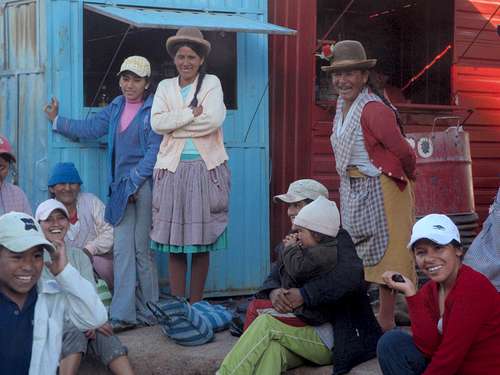-
 9835 Hits
9835 Hits
-
 84.27% Score
84.27% Score
-
 18 Votes
18 Votes
|
|
Mountain/Rock |
|---|---|
|
|
20.9184°S / 66.03552°W |
|
|
Hiking, Mountaineering |
|
|
Spring, Summer, Fall |
|
|
18110 ft / 5520 m |
|
|
Overview
Cerro Chorolque, a highly eroded dormant volcano, is the highest mountain in the Cordillera de Chichas followed by Cuzco, Tazna, and Huanchaca. The Cordillera de Chicas is a subgroup of the Bolivian Andes Cordillera Central. Chorolque is the highest mountain in the area and has (1542 meters / 5059 feet) of prominence so it can be seen for hundreds of miles around. It's steep faces and ridges give it a pyramidal appearance from many angles. Although it's rarely climbed for reasons other than mining, it's certainly one of the more impressive looking peaks in Bolivia.
Satellite images show that all sides have undergone drastic changes from the original form with the exception of one remaining even slope. While most faces of this peak have deep gullies and craggy rotten ridges, the southwest slope has retained most of its original form. Even more exciting news for the prospective climber is that there is a road which zigzags up this slope to (5000 meters / 16,000 feet).
If you decide to climb Cerro Chorolque, you will likely be the only one doing so. It's very important to follow a proper plan for acclimatization. Premature exposure to these altitudes can prove fatal. It is suggested that prospective climbers, especially those who live at low altitudes, visit a few lower peaks in the days preceding a Chorolque climb. Allowing the body time to adjust is key.
Mining and Santa Bárbara
Due to the low rainfall in this part of Bolivia, the landscape would be uninhabited except for the rich mineral content and the availability of jobs in the mining industry. In fact, Chorolque is home to one of the highest mining operations in the world, which collects ore all the way up to the summit above 18,000 feet. These mines are the highest tin and bismuth mines in the world and the village of Santa Bárbara, located at 15,600 feet on the western slopes, is the highest village in Bolivia.
The village of Santa Bárbara is small, with less than 5000 inhabitants and most of them are miners. They own the access roads which lead up the southwest slope so it recommended that you treat the locals with respect in your attempt to get permission to use the road. Ask around until you find the office with the right mining officials and ask politely if you can drive up the access road above town. If they say no, it might be necessary to offer a bribe or hire someone to accompany you during the trek. A last resort would entail parking your car in town and walking up the road on foot. It's only an extra hundred meters or so.
The main ore which is pulled from the mines is tin but gold and other metals appear in smaller amounts. The mines of Chorolque are well known among mineral collectors for unique specimens of cassiterite, apatite, and bismuthinite. For a complete list of the minerals found in these mines refer to this page. To see some photo samples of the specimens refer to this page. These mining operations were first sold to western investors in 1889 when the Aramayo Francke Company purchased all the mines in the greater Tupiza area, establishing a monopoly on Bolivian bismuth production.
Standard Route
Walk or drive to the end of the road which is east of the village and visible on the upper southwest slope. From the end of the mining access road, follow miners trails as they switchback up the slope. At some point around (5300 meters / 17,400 feet) you will come to the end of any visible trail-way. From here on it's a matter of ascending the rotten talus slopes the rest of the way to the summit. The slope narrows near the top with drop-offs on either side so exercise caution. Also, be wary of loose rocks. Some of them are big and could do a lot of damage if they get started rolling.
Getting There
There are two ways to drive to Santa Bárbara. From the southeast it can be approached from the town of Tupiza. From the northwest it can be approached from the town of Uyuni.Tupiza Approach
From downtown Tupiza drive north on the main road for 2 kilometers until you reach the edge of town. Turn left at the junction which immediately crosses the riverbed. This next stretch of road crosses through the Montes Chichas Este which contains some of the most amazing countryside in all of Bolivia. This part of the country is famous for its strange geological formations and red rock. Those who have visited North America's national parks will be reminded of Badlands NP, Zion NP, Arches NP, and Monument Valley. Continue to follow this road for 91.8 kilometers to a T junction. Cerro Chorolque should be visible off to the right for the last 15 kilometers. Turn right at the T junction and follow the road for 19 kilometers up to Santa Bárbara.
Uyuni Approach
If you are in the town of Uyuni, hopefully you have taken the time to visit the Salar de Uyuni which is the largest salt flat on earth and also the flattest place on earth. From the main intersection downtown Uyuni where Highway 602 crosses Highway 701, follow 701 southwest to the edge of town. There is a Y junction with 701 leading away in a southwestern direction and an unnamed road leading away in a southeastern direction. Follow the unnamed southeastern road for 112 kilometers to an intersection. You will know you have taken the right road when after 11 kilometers the road turns more to the east. At the intersection the main road turns south but to get to Santa Bárbara you will want to proceed onto the side road which continues eastward. Follow this road from the junction for 19 kilometers up to Santa Bárbara.
AMS / HACE / HAPE
Make sure you know the difference between normal altitude sickness and the more serious HACE and HAPE. It's quite common to have a headache or loose you appetite at altitude, but if you or someone you climb with was to get seriously ill, could you diagnose it in time? Knowing what to watch for, and making the decision to turn around without delay, might save a life.Daughter of Chorolque
In 2007 a film by South Korean director Misun Park was released about the town of Santa Bárbara and the mines of Chorolque. Below are some short descriptions of the film and the websites from which they were borrowed.In earlier times, women weren't allowed to work in the mines. But the women wanted to work there so they fought for this right to work. Today, a lot of women work in the mines. The work is hard and the conditions are not good. The work causes them much distress and we see how they work until they are physically exhausted. The question arises – is this type of work really a sign of progress for the women there? On the other hand, these mothers don't have many other ways to earn a living.
Most of the married men have either left the village or have already died. Most miners who work at Chorolque don't live past the age of 45. The women have strong characters and are prepared to do a lot for their children. People in Bolivia seem to care very much about children. Although there is much poverty, the children are often given presents. We see a lot of happy children's faces in the movie. But we know that they will grow up to be adults. We sense that their future will not be very rosy.
But the film doesn't just show the bad sides of working there. It shows us how the people in the mines enjoy the simple pleasures of life.
(http://www.realeyz.tv/en/mi-sun-parkdaughter-of-chorolque_cont3551.html)
Emancipation for women in a Bolivian mining village - the right to go into the depths of the earth to work alongside men. We witness their backbreaking work but also realize the beauty that is present in the lives of the daughters of Chorolque.
5600 metres above sea level in the Bolivian mining village of Chorolque emancipation for women means having earned the right to work alongside men in the depths of the earth. Today there are 20 women who work in the tin mine among 1000 men. In 1990, Pascuala was the first woman to be allowed to go down the shafts to work, breaking the tradition that forbade females to take employment. Now aged 56, she has been campaigning for the past 18 years for her fellow women's right to independence and recognition in a patriarchal world. This ethnographic film enters into the harsh environment of the mine with women who have followed in Pascuala's footsteps, such as Carmela and her daughter. Deep underground the sound of hammers resonates in the chambers and we witness the backbreaking work of the miners. The stresses and strains are evident in their grubby faces and calloused hands. In contrast, on the surface of the earth, stunning landscapes reveal a poignant beauty, a beauty that is also present in the lives of the daughters of Chorolque.
(http://docalliancefilms.com/film/7392-daughter-of-chorolque/)


